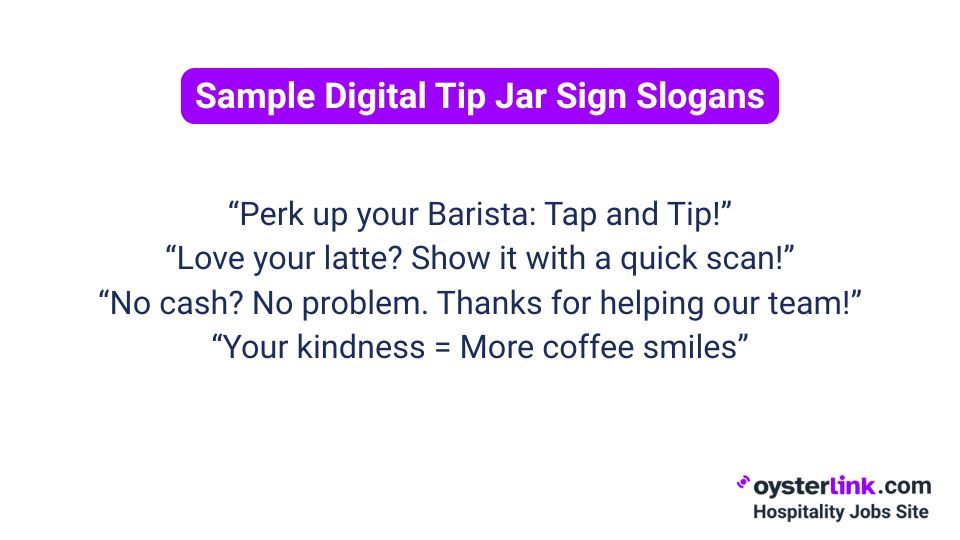Fewer customers carry cash these days, so your staff might miss out on well-earned tips. Switching to digital tip jars ensures they still get recognized.
If you own a cafe, bar or restaurant, digital tips can help stabilize unpredictable income, reduce confusion and keep your team happy.
In this article, you’ll discover practical tips and a step-by-step guide to help you successfully implement your digital tip system.
Step-By-Step Guide To Setting Up Digital Tip Jars
Getting started with digital tipping is straightforward if you approach it methodically.
Here’s a step-by-step process to help you choose the right platform, configure your accounts and implement everything smoothly.
1. Evaluate your digital tipping options
Start with a little research. Look at platforms that actually fit your business. Venmo, PayPal, Cash App and TipYo are the main ones these days. Pay attention to transaction fees, user friendliness and of course, payment security.
See if your existing POS setup (like Square or Toast) works directly with any platforms — it’ll save you time later. No one likes running reports across three different apps at closing.
It’s a good idea to connect with a local group of business owners or ask around on social networks before you make a final decision.
They can tell you honestly about hidden fees, tricky customer service issues and whether guests actually use the app. A few minutes of research now can save you a lot of headaches down the line!
2. Create and configure accounts for the staff or the business
Decide up front: One big business account or individual staff profiles?
Business accounts wired to your main bank make payout smooth, but double-check the account name (think “The Coffee Spot Tips” or “Tips for Team Java”— no need for confusion).
Set privacy controls so guests only see what’s essential. Review security settings, since nobody wants a tip jar hack story in next week’s neighborhood Facebook group.
For smaller crews, pooled tip accounts are just easier to wrangle — and usually feel fairer. Still, make sure you’re on the right side of local labor laws!
3. Generate QR codes or tipping links
Most digital tip services allow you to create unique QR codes or links for each “jar.”
For the best results, use the official app or website, but be sure to test them on a staff phone or two before printing.
Make sure to test the codes on both Android and iPhone devices, and keep the links short and simple. After all, your guests might be grabbing coffee in a rush!
Don’t be afraid to get creative with your signage: try out different designs by posting a few versions and letting your team vote on their favorites.
4. Design and display signage at points of sale
Print or order signs with your codes/links. Try table tents, mini easels or a poster by the register if you have the space.
Light-hearted prompts (“Love your Latte? Tip your Barista!” or “Help us fund more latte art practice!”) add a human touch that can help tips flow.

Remember to update your designs seasonally to keep things fresh and engaging.
What gets smiles in December might not have the same effect in July, so switching things up helps maintain interest and humor throughout the year.
5. Train staff on digital tipping procedures
Make sure all staff members — from your morning regulars to the new weekend Barista — know how the electronic tip jar works.
Walk through the basics, demonstrate how the scanning process feels and then flip the script: have them try it out as a “customer” using their own device.
If a guest is stuck — or worried about privacy — your staff should be able to help without missing a beat. Share what to say and when; it pays off.
6. Inform and encourage customers to use digital tip jars
Let guests know you offer digital tipping. Sometimes a simple “Did you know you can scan and tip now?” at checkout makes shy customers more likely to chip in.
Share your tip jar link on social media, your website and in email campaigns so regulars get the memo — even if they’re skipping drinks that week.
Cost of Setting Up Digital Tip Jars
The main costs usually come from transaction fees, which typically range from 1–3% per transaction. Printing signs or buying a stand are relatively small expenses that most budgets can handle easily.
However, it's crucial to review each platform for any hidden fees so you can avoid unexpected costs later on.
Try using the digital tip jar at just one counter or station for about a week. This helps you see if customers are willing and comfortable using it before you roll it out everywhere or print new signs. It’s a simple way to test the system and make any necessary adjustments early on.
Best Practices for Managing Digital Tips
Implementing effective strategies for tip management helps ensure fairness, accuracy and compliance. Consider the following best practices:
- Establish a clear tip-splitting method early: Decide whether to distribute tips by shift, position, hours worked or another approach that fits your team culture. Consistency is key.
- Track digital tip income regularly: Use transaction logs provided by platforms to review tips at tax time, and conduct monthly spot checks to identify discrepancies early.
- Communicate policies clearly: Ensure all staff members understand the tip-splitting policy from the outset. Avoid making mid-month changes to prevent confusion.
- Utilize shared tools for verification: Use a shared Google Sheet or your POS’s built-in reports to collaboratively verify tip amounts, especially in busy environments with many shifts.
- Understand staff responsibilities: For teams with significant Server roles, familiarize yourself with their duties to manage tips fairly and maintain transparency.
Benefits of Digital Tip Jars
Electronic tip jars provide guests with a convenient way to tip, even when they don’t have cash on hand. This benefits your business and helps keep your team motivated.
They also reduce cash handling, leading to less frequent cleaning and hand washing. Digital tracking makes tip management much easier, helping you stay organized with minimal effort.
Since many guests in their twenties prefer digital payments, offering this option has become increasingly important.
Additionally, after a busy shift, there’s no longer the hassle of searching for a missing tip jar, saving valuable time and removing unnecessary stress.
See also: Should Your Restaurant Go Cashless? Pros and Cons of Digital Payments
Potential Challenges of Using Digital Tip Jars
Not every guest or employee will be immediately enthusiastic about using digital tips. Expect questions and plan how your team should explain the process patiently.
Regarding privacy, choose platforms that do not require customers to share personal details. If technology encounters an issue, have a backup paper jar ready.
Additionally, remember to update your QR codes whenever you switch platforms to avoid confusion.
About OysterLink
OysterLink is a platform designed for restaurant professionals and employers, making it simple to find great hospitality jobs or hire the right talent quickly.
We give job seekers helpful salary insights, career advice and the best job listings, while providing employers with tools to create compelling job ads, find suitable candidates, and access helpful resources.
Our goal is to connect opportunity and talent, making hiring and career growth easier for everyone in the restaurant and hospitality industry.











Loading comments...